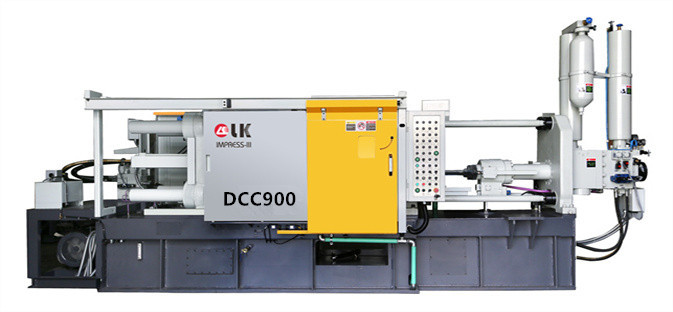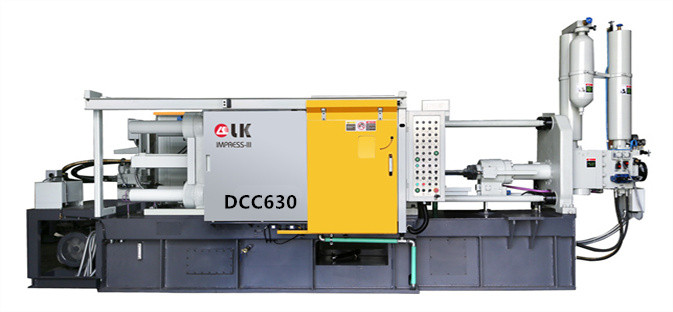Emerging Trends and Technologies in Die Casting
LK Die Casting Machine / 2024-07-04 17:27:55
Die casting is an efficient and precise manufacturing process that is widely used in the automotive, aerospace, electronics, home appliances, and other industries.
With the advancement of technology and changes in market demand, die-casting technology is also developing.
This article will explore emerging trends and technologies in the field of die-casting to help readers understand the latest developments and provide references for related industries.

1. Application of lightweight materials
Aluminum alloys
Aluminum alloys have attracted widespread attention due to their lightweight, high strength, and strong corrosion resistance. In recent years, aluminum alloys have
been increasingly used in the automotive and aerospace fields, especially in the manufacture of engine parts and structural parts.
Magnesium alloys
Magnesium alloys are lighter than aluminum alloys and have good mechanical properties and machinability.
Its application in electronic products and automotive parts is gradually increasing, especially for the manufacture of lightweight structural parts.
Composite materials
Composites can achieve lightweight and high performance by combining different materials.
Carbon fiber-reinforced composites are increasingly used in aerospace and high-end automotive manufacturing, significantly improving the performance and life of products.
2. Digitalization and Intelligent Manufacturing
Digital Twin
Digital twin technology creates digital models of physical equipment to achieve real-time monitoring and optimization of equipment operating status.
In the field of die-casting, digital twin technology can be used to simulate and optimize die-casting processes, and improve production efficiency and product quality.
Internet of Things (IoT)
IoT technology can realize remote monitoring and management of equipment by connecting equipment.
In die-casting factories, IoT technology can collect and analyze production data in real-time, promptly discover and solve problems in production, and improve
production flexibility and response speed.
Artificial Intelligence (AI)
Artificial intelligence technology can optimize die-casting process parameters and improve product quality through machine learning and data analysis.
AI can also predict equipment failures, develop preventive maintenance plans, and reduce equipment downtime.
3. Additive Manufacturing and Hybrid Manufacturing
Additive Manufacturing
Additive manufacturing technology (such as 3D printing) can manufacture parts with complex shapes by stacking materials layer by layer.
In the field of die-casting, additive manufacturing technology can be used to manufacture molds, improving mold design flexibility and manufacturing efficiency.
Hybrid manufacturing
Hybrid manufacturing technology combines the advantages of additive manufacturing and traditional subtractive manufacturing and can achieve efficient and high-
precision manufacturing. In the die-casting process, hybrid manufacturing technology can be used to manufacture complex molds and parts, improving production
efficiency and product quality.
4. Innovation in surface treatment technology
Plasma surface treatment
Plasma surface treatment technology can significantly improve the wear resistance and corrosion resistance of parts by forming a dense protective layer on the
surface.
This technology has been widely used in the manufacture of automotive and aerospace parts.
Laser surface treatment
Laser surface treatment technology can improve the hardness and wear resistance of parts by treating the surface of parts with laser beams.
This technology has important applications in the manufacture of high-performance parts.
Electroplating and coating technology
Electroplating and coating technology can improve the surface performance of parts by depositing a layer of metal or non-metallic material on the surface of parts.
The development of new electroplating and coating materials has further improved the wear resistance, corrosion resistance, and decorativeness of parts.
5. Environmental protection and sustainable development
Green Manufacturing
Green manufacturing achieves environmental protection and sustainable development by reducing energy consumption and waste emissions. Optimization and improvement of
die-casting processes, such as the use of energy-saving equipment and recycling of waste materials, are important contents of green manufacturing.
Environmentally friendly materials
Environmentally friendly materials reduce the impact on the environment by reducing the use of harmful substances. In the field of die-casting, the development and
application of environmentally friendly materials, such as lead-free aluminum alloys and degradable magnesium alloys, help to achieve sustainable development.
Resource recycling
Resource recycling reduces resource consumption and environmental pollution by recycling and reusing waste materials.
In die-casting plants, waste recycling and reuse technologies, such as remelting and reprocessing of metal waste, are important means of resource recycling.
6. Optimization and improvement of die-casting process
High-pressure die-casting
High-pressure die-casting technology can significantly improve the density and mechanical properties of parts by increasing the injection pressure of molten metal.
This technology has important applications in the manufacture of high-performance parts.
Vacuum die-casting
Vacuum die-casting technology can reduce pores and inclusions in parts and improve the quality and performance of parts by extracting air from the mold during the
die-casting process.
Semi-solid die casting
Semi-solid die-casting technology improves the molding accuracy and surface quality of parts by controlling the temperature of molten metal to keep it in a semi-
solid state. This technology has important applications in the manufacture of high-precision parts.
7. Advances in mold manufacturing technology
High-precision mold manufacturing
High-precision mold manufacturing can produce high-precision, high-quality molds by adopting advanced processing equipment and processes, such as CNC machining and
discharge machining, and improve the molding accuracy and surface quality of parts.
Innovation of mold materials
New mold materials can extend the service life of molds and reduce production costs by improving the hardness and wear resistance of materials.
The development and application of new mold materials such as high-strength steel and titanium alloy are important advances in mold manufacturing technology.
Optimization of mold design
The optimization of mold design can optimize the structure and performance of molds and improve the design efficiency and quality of molds by adopting advanced
design tools and methods, such as computer-aided design (CAD) and finite element analysis (FEA).
8. Automation and intelligent production lines
Robotics technology
Robotics technology can realize the automation and intelligence of production lines and improve production efficiency and product quality by introducing industrial
robots.
In die-casting factories, robotics can be used for parts handling, assembly, and testing.
Automated production line
Automated production lines can realize automation and continuity of the production process and improve production efficiency and product quality by integrating
automation equipment and systems. In die-casting factories, automated production lines can be used for metal melting, injection, cooling, and processing.
Intelligent production system
Intelligent production systems can realize intelligent and flexible production processes and improve production flexibility and response speed by adopting advanced
information technology and control technology. In die-casting factories, intelligent production systems can be used for production planning, quality control, and
equipment maintenance.
9. New die-casting equipment
High-speed die-casting machine
High-speed die-casting machines can significantly improve the molding speed and quality of parts by increasing the injection speed of molten metal.
This equipment has important applications in large-scale production.
Multi-function die-casting machine
Multi-function die-casting machines can realize integrated processing of parts and improve production efficiency and product quality by integrating multiple
processing functions such as drilling and tapping.
Intelligent die-casting machine
Intelligent die-casting machines can realize real-time monitoring and optimization of the die-casting process by integrating advanced control systems and sensors,
and improve the automation and intelligence level of the equipment.
10. Future prospects in the field of die-casting
Technology integration
The integration of die-casting technology with other manufacturing technologies, such as additive manufacturing and nanotechnology, will bring new manufacturing
models and product forms, and further enhance the performance and application scope of the die-casting process.
Environmental protection and sustainable development
The die-casting field will pay more attention to environmental protection and sustainable development, and achieve green manufacturing and sustainable development
through the use of environmentally friendly materials, energy-saving equipment, and resource-recycling technology.
Digitalization and intelligence
Digitalization and intelligence technologies will be more widely used in the field of die-casting.
Through technologies such as digital twins, the Internet of Things, and artificial intelligence, the production process will be digitalized and intelligentized,
and production efficiency and product quality will be improved.

Conclusion
The emerging trends and technologies in the field of die-casting demonstrate the huge potential of this traditional manufacturing process driven by modern
technology.
Lightweight materials, digital and intelligent manufacturing, additive, and hybrid manufacturing, innovation of surface treatment technology,
environmental protection and sustainable development, process optimization, progress in mold manufacturing technology, automation, and intelligent production
lines, development of new die-casting equipment, and future prospects are all important directions for the continuous evolution of die-casting technology.
Understanding and applying these emerging trends and technologies will be the key to improving competitiveness and achieving sustainable development for
enterprises in the die-casting industry.
Contact LK Egypt to learn more info about the die-casting machine
LKAGENT OFFICE DCM
Address: Industry Zone, South of Port Said Kebly, Egypt
https://www.zazdiecasting.com/
Phone: +86 13598704163
Mobile: +20 101 304 3317 +20 150 181 8310
Email: jack@zazmae.com ahmedmahmoud@zazmae.com
#die cast tooling
#trivalent chromate
#rapid prototype casting
#a360 aluminum
#aluminum caster
#aluminum prototype
#ideal 55 slider parts
#density of aluminum kg/mm3
#magnesium sheet metal
#parts of a metal gate
#subcontracting of screw machining for the luxury sector
#wall aluminum
#die casting tooling
#tooling for die casting
#density of aluminium in kg mm3
#clear chromate
#es casting metals
#gating material
#prototype aluminum
#sigma castings
#subcontracting of screw-machining for household appliances
#we squeeze to please machine
#aluminium gravity die casting
#aluminum part
#aluminum rapid prototyping
#nickel casting
#plunger tip for die casting machine
#rapid prototyping aluminium
OTHER CONTENT
-

2024-09-19 14:16:15 LK Cold Chamber Die Casting Machine DCC900 Locking Force: 9000KN Die Height: 400-1000mm Space Between Tie Bars: 930x930mm Shot Weight: 13.5Kg Casting Area Max:2250c㎡
More -

2024-09-19 14:11:06 LK Cold Chamber Die Casting Machine DCC280 Locking Force: 2800KN Die Height: 250-650mm Space Between Tie Bars: 560x560mm Shot Weight: 2.9Kg Casting Area Max:700c㎡
More -

2024-09-19 10:23:07 LK Cold Chamber Die Casting Machine DCC580 Locking Force: 5000KN Die Heigh: 350-850mm Space Between Tie Bars: 760x760mm Shot Weight: 6.9Kg Casting Area Max:1250c㎡
More -

2024-09-19 10:11:20 LK Cold Chamber Die Casting Machine DCC400 Locking Force: 4000KN Die Height: 300-700mm Space Between Tie Bars: 669x669mm Shot Weight: 4.7Kg Casting Area Max:1000c㎡
More

